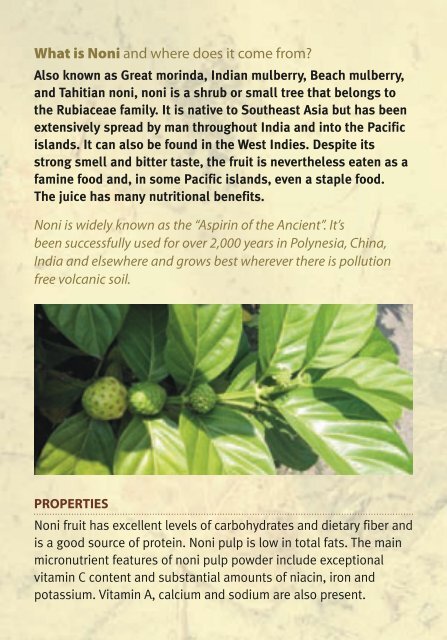Species brochure-Noni Morinda citrifolia.pdf - Crops for the Future
Species brochure-Noni Morinda citrifolia.pdf - Crops for the Future
Species brochure-Noni Morinda citrifolia.pdf - Crops for the Future
Create successful ePaper yourself
Turn your PDF publications into a flip-book with our unique Google optimized e-Paper software.
What is <strong>Noni</strong> and where does it come from?<br />
Also known as Great morinda, Indian mulberry, Beach mulberry,<br />
and Tahitian noni, noni is a shrub or small tree that belongs to<br />
<strong>the</strong> Rubiaceae family. It is native to Sou<strong>the</strong>ast Asia but has been<br />
extensively spread by man throughout India and into <strong>the</strong> Pacific<br />
islands. It can also be found in <strong>the</strong> West Indies. Despite its<br />
strong smell and bitter taste, <strong>the</strong> fruit is never<strong>the</strong>less eaten as a<br />
famine food and, in some Pacific islands, even a staple food.<br />
The juice has many nutritional benefits.<br />
<strong>Noni</strong> is widely known as <strong>the</strong> “Aspirin of <strong>the</strong> Ancient”. It’s<br />
been successfully used <strong>for</strong> over 2,000 years in Polynesia, China,<br />
India and elsewhere and grows best wherever <strong>the</strong>re is pollution<br />
free volcanic soil.<br />
PROPERTIES<br />
<strong>Noni</strong> fruit has excellent levels of carbohydrates and dietary fiber and<br />
is a good source of protein. <strong>Noni</strong> pulp is low in total fats. The main<br />
micronutrient features of noni pulp powder include exceptional<br />
vitamin C content and substantial amounts of niacin, iron and<br />
potassium. Vitamin A, calcium and sodium are also present.

















